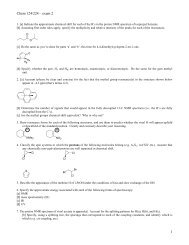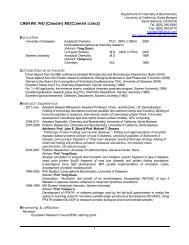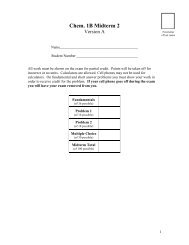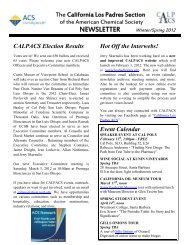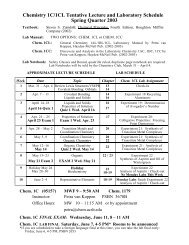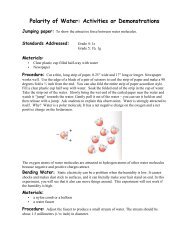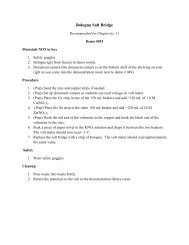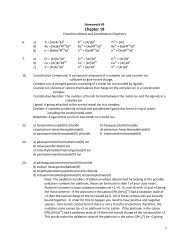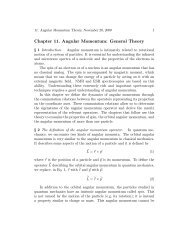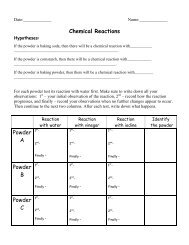29 Si NMR Some Practical Aspects - Pascal-Man
29 Si NMR Some Practical Aspects - Pascal-Man
29 Si NMR Some Practical Aspects - Pascal-Man
You also want an ePaper? Increase the reach of your titles
YUMPU automatically turns print PDFs into web optimized ePapers that Google loves.
Gelest, Inc.<br />
Table 1<br />
Group 14 elements, parameter of selected isotopes<br />
Natural Nuclear Magnetic Sensitivity Recept.<br />
Abundance Spin Moment µ d rel.<br />
[%] rel. a) abs. b) to 13 C<br />
13C 1.108 1/ 2 07022 1.59x10 -2 1.76x10 -4 1<br />
<strong>29</strong><strong>Si</strong> 4.7 1/ 2 -0.5548 7.84x10 -3 3.69x10 -4 2.1<br />
73Ge 7.76 9/ c) 2 -0.8768 1.4x10 -3 1.08x10 -4 0.61<br />
119Sn d) 8.58 1/ 2 -1.0409 5.18x10 -3 4.44x10 -3 25.2<br />
207Pb 22.6 1/ 2 0.5843 9.16x10 -3 2.07x10 -3 11.8.<br />
a) at constant field and equal number of nuclei; b) product of relative sensitivity and natural abundance; c) quadrupole<br />
moment, -0.18 x 10 -28 m; d) isotope used in most tin <strong>NMR</strong> experiments, for other relevant nuclei see literature [1] and<br />
cited reviews.<br />
Table 1 shows that <strong>29</strong> <strong>Si</strong> has a higher share in the isotopic mixture but the absolute value of the magnetic<br />
moment is slightly lower than of 13 C. This leads to a lower resonance frequency. A complication arises from<br />
the fact that spin and magnetic moment are antiparallel leading to a negative sign of the gyromagnetic ratio .<br />
Concerning these facts silicon <strong>NMR</strong> had a slow start. After the first report by Lauterbur et al. in 1962 [2] there<br />
have been a few papers per year only. However, since the beginning of the 80´s this has changed dramatically.<br />
Our own data collection of <strong>29</strong> <strong>Si</strong> chemical shifts now contains about 13.000 data sets for more than 6.500 compounds<br />
[3]. A quick search in literature yields around 25.000 compounds with a measured <strong>29</strong> <strong>Si</strong> chemical shift.<br />
Because of these huge amounts of material available in silicon <strong>NMR</strong>, all discussions or reviews must be limited<br />
to special and selected research fields.<br />
2. General aspects<br />
2.1 Using of standards<br />
The only magnetic isotope of silicon <strong>29</strong> <strong>Si</strong> has a natural abundance of 4.7%, a spin of 1 / 2 , a magnetic moment<br />
of -0.9609 and therefore a receptivity of 3.69 x 10 -4 compared to that of 1 H. It can be characterized as a magnetically<br />
diluted isotope of medium sensitivity [4]. <strong>Si</strong>milar to 1 H or 13 C <strong>NMR</strong> the referencing is mostly done<br />
relatively to tetramethylsilane (Me 4 <strong>Si</strong>, TMS) which has the advantages of having a low boiling point, a relatively<br />
short relaxation time and being a chemically relatively inert substance. Therefore, if nescessary, it can<br />
be added directly to the sample. However, its resonance is in a shift range where the resonances of many other<br />
organosilicon compounds occur and so misinterpretations are possible. Two general strategies are usable to<br />
avoid this problem. The first one is the use of secondary standards. <strong>Some</strong> secondary reference standards as<br />
known from literature are collected in Table 2. Unfortuanately, due to their higher reactivity, in contrast to<br />
TMS, they are useful only for a limited number of applications.<br />
AZmax TEL: 035543-1630 • FAX: 03-5543-0312 • www.azmax.co.jp<br />
(215) 547-1015 • FAX: (215) 547-2484 • www.gelest.com<br />
209




